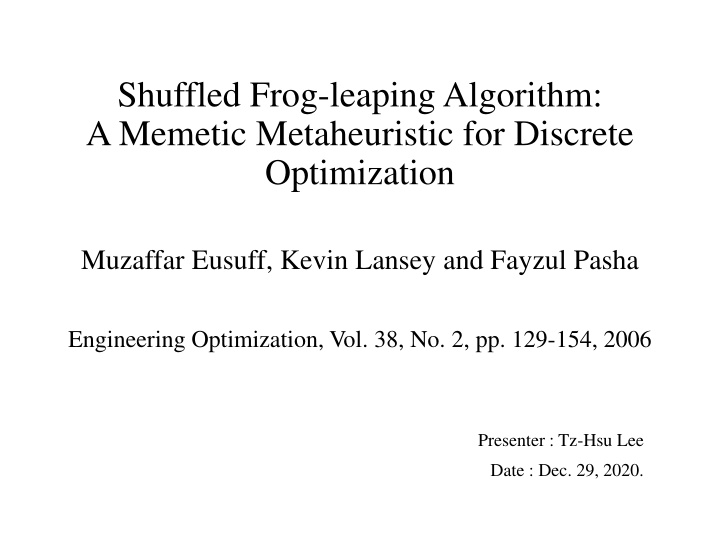
Shuffled Frog-Leaping Algorithm: A Memetic Metaheuristic for Optimization
"Explore the Shuffled Frog-Leaping Algorithm (SFLA), a population-based cooperative search method inspired by natural memetics. Learn how SFLA integrates local search and global information exchange, enhancing combinatorial optimization capabilities. Discover the effectiveness of SFLA through experimental results and real-world application in groundwater modeling and water distribution system design."
Download Presentation

Please find below an Image/Link to download the presentation.
The content on the website is provided AS IS for your information and personal use only. It may not be sold, licensed, or shared on other websites without obtaining consent from the author. If you encounter any issues during the download, it is possible that the publisher has removed the file from their server.
You are allowed to download the files provided on this website for personal or commercial use, subject to the condition that they are used lawfully. All files are the property of their respective owners.
The content on the website is provided AS IS for your information and personal use only. It may not be sold, licensed, or shared on other websites without obtaining consent from the author.
E N D
Presentation Transcript
Shuffled Frog-leaping Algorithm: A Memetic Metaheuristic for Discrete Optimization Muzaffar Eusuff, Kevin Lansey and Fayzul Pasha Engineering Optimization, Vol. 38, No. 2, pp. 129-154, 2006 Presenter: Tz-Hsu Lee Date : Dec. 29, 2020.
Abstract(1/3) A memetic meta-heuristic called the shuffled frog-leaping algorithm (SFLA) has been developed for solving combinatorial optimization problems. The SFLA is a population-based cooperative search metaphor inspired by natural memetics. The algorithm contains elements of local search and global information exchange. The SFLA consists of a set of interacting virtual population of frogs partitioned into different memeplexes. The virtual frogs act as hosts or carriers of memes where a meme is a unit of cultural evolution. The algorithm performs simultaneously an independent local search in each memeplex. The local search is completed using a particle swarm optimization-like method adapted for discrete problems but emphasizing a local search.
Abstract(2/3) To ensure global exploration, the virtual frogs are periodically shuffled and reorganized into new memplexes in a technique similar to that used in the shuffled complex evolution algorithm. In addition, to provide the opportunity for random generation of improved information, random virtual frogs are generated and substituted in the population. The algorithm has been tested on several test functions that present difficulties common to many global optimization problems. The effectiveness and suitability of this algorithm have also been demonstrated by applying it to a groundwater model calibration problem and a water distribution system design problem.
Abstract(3/3) Compared with a genetic algorithm, the experimental results in terms of the likelihood of convergence to a global optimal solution and the solution speed suggest that the SFLA can be an effective tool for solving combinatorial optimization problems.
Meme Meme is a contagious information pattern that replicates by parasitically infecting human and/or animal minds and altering their behavior, which causes them to propagate the pattern. Examples of memes are songs, ideas, catch phrases, clothes fashions and ways of making pots or of building arches. Memes propagate themselves in the meme pool by leaping from brain to brain via a process that, in the broad sense, can be called imitation.
Comparison of Memes and Genes Memes : Increased communicability among the hosts. Can be transmitted between any two individuals. Can be transmitted in the space of minutes. Can take over a meme from a single individual is almost unlimited. Spreading is much faster, can be improved by the person. Genes : For sexual reproducibility. Can only be transmitted from parents or parent. Transmitted between generations. Restricted by the rather small number of offspring from a single parent.
Shuffled Frog-leaping Algorithm(SFLA)(3/5) 1. Find ?? and ?? 2. Construct a submemeplex ??= 2(n + 1 j ) / n(n + 1), j = 1, . . . , n 3. Improve the worst frog s position ex : ?? = (1, 3, 5, 1, 6), ?? = (4, 6, 2, 1, 7), ????= 3, rand() = 0.7 new?? = (3, 5, 3, 1, 6) (1 + min{int[rand()(4 - 1)], 3}) = (1 + 2) (5 + max{int[rand()(2 - 5)], -3}) = (5 - 2)
Shuffled Frog-leaping Algorithm(SFLA)(4/5) if new??not better than ?? if new??still not better than ?? random a new frog to replace ?? 4. Update ?? and ?? 5. Repeat N times for every memeplex Shuffle memeplexes sort frogs and partition frogs into memeplexes again
